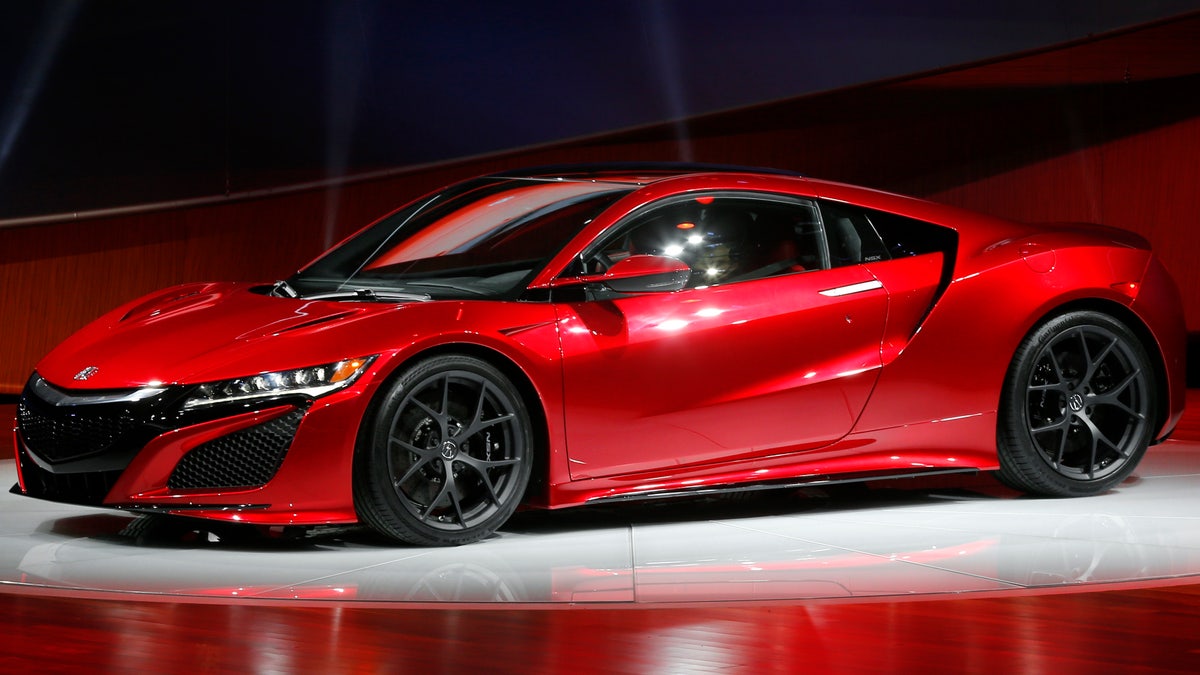
The Acura NSX debuts at media previews for the North American International Auto Show in Detroit Monday, Jan. 12, 2015. (AP Photo/Paul Sancya)
Heralded in its heyday as the “$40,000 Ferrari,” the Acura NSX carved new ground for Honda in the performance enthusiast world, winning praise everywhere it went, and remaining highly sought after today. Yet, somehow, Acura and parent company Honda let the NSX flounder and eventually fade into the history books. No more. The NSX is back.
Unveiled today at the 2015 Detroit Auto Show after a preview to select media last night, the new Acura NSX (or Honda NSX as much of the rest of the world knows it), sports considerably higher technology than the original, but its bloodlines are clear.
From the mid-engine layout to the exterior design, it’s clear Honda and Acura are seeking to evoke the memory of the original; at the same time, it’s equally obvious that this is an entirely new—and very different—car. The engine is still a V-6, but this time it’s a 75-degree unit mounted longitudinally in the chassis, rather than a 90-degree bank angle and transverse mounting.
The 75-degree angle is a bit of an odd one for a V-6, but it’s been proven in Honda’s twin-turbocharged Indycar engines over the past several seasons. The valvetrain of the new V-6 is also race-derived, with a compact layout, and the oil system is of the dry sump type. Of course, the NSX’s new V-6 is also twin-turbocharged, but that’s not all the assistance it gets: there are three electric motors aiding the acceleration, offering hybrid and electric drive modes, and more.
Up front, a pair of electric motors help provide more forward traction, as well as vector torque to improve handling. The rear electric motor aids accelerating, braking, and transmission shift quality. Despite these details, Acura has yet to release any power output, performance, gas mileage, or electric range capabilities for the NSX.
A nine-speed dual-clutch transmission developed by Acura delivers the shifts, promising race-car-quick gear changes. After all, Acura calls the NSX a “human-centered supercar,” and promises “an uncompromising focus on the driver.” Despite this driver focus, Acura makes no sounds about the potential for a true three-pedal manual transmission.
Fans of the NSX will recall the saga of Acura trotting out the concept car at several shows over the past three years. While the new production version of the NSX shares much of its aesthetic with the concept, some changes had to be made on the road to the final design.
Among those changes are a longer body (about 3.1 inches) due to the change to a longitudinal layout for the V-6 engine and nine-speed transmission; it’s about 1 inch wider for greater comfort in its more cab-forward packaging; and the wheelbase and height have grown 0.8 inches and 0.6 inches respectively.
Other visual differences include new vents in the front bonnet; new front fender vents; modified side air intakes (including a flying buttress-style design not unlike the BMW i8’s) as well as an optimized rear deck spoiler. The changes, in other words, have come from necessity, dictating that form follow function.
Underlying the visual and mechanical bits is a multi-material body composed of aluminum, steel, carbon fiber, and other materials. The space frame itself is made largely of aluminum with ultra-high strength steel; a carbon fiber floor adds torsional rigidity. The body panels are a combination of Sheet Molding Composite (SMC) and aluminum.
A combination of 19- and 20-inch wheels front and rear house 245/35 (front) and 295/30 (rear) Continental ContiSport Contact tires for grip. All-aluminum suspension components minimize unsprung weight. Six-piston front and four-piston rear brake calipers grab carbon-ceramic brake discs for maximum fade-resistant stopping power.

Next-Generation Acura NSX Interior (© 2015 American Honda Motor Co., Inc.)
Under the driver’s hand in the center stack lies the Integrated Dynamic System, which offers several drive modes, including: Quiet, Sport, Sport+, and Track. Quiet allows for low-speed, short-duration electric-only driving; Sport and Sport+ modes raise the intensity level for street environments; Track mode maximizes the NSX’s performance, although Acura hasn’t yet expanded upon what that means. There’s also a “launch” function, which will allow the NSX to rip off its quickest 0-60 mph times, employing the full blast of the twin-turbo V-6 engine and its three electric motors.
For JDM fans, the NSX will cause a few mixed emotions: it’s not being built in Japan at all. In fact, the sole production facility for the new NSX will be the company’s Marysville, Ohio Performance Manufacturing Center. Roughly 100 of Acura’s most skilled technicians will oversee the construction of the cars, sending them off to buyers in markets all over the world.
For more Detroit Auto Show coverage, head to our dedicated hub.